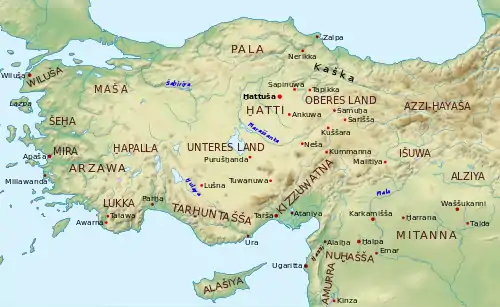Pala Pala | |||||||||
|---|---|---|---|---|---|---|---|---|---|
| Unknown–at the latest 1178 BC | |||||||||
 The location of Pala in Northern Bronze Age Anatolia | |||||||||
| Capital | Unknown | ||||||||
| Common languages | Palaic | ||||||||
| Religion | Palaic religion | ||||||||
| Historical era | Bronze Age | ||||||||
• Established | Unknown | ||||||||
• Disestablished | at the latest 1178 BC | ||||||||
| |||||||||
| Today part of | Turkey | ||||||||
Pala (Cuneiform: pa-la-a)[1] was a Bronze Age country in Northern Anatolia. Little is known of Pala except its native Palaic language and its native religion. Their language shared common innovations with Luwian not present in the Hittite language suggesting a prior Luwian-Palaic linguistic complex.[2]
Location
Pala is said to have been bordered by Tummana to the east, Kalasma to the west and Kaissiya to Mount Asharpaya toward the south.[3] The country named *Bla leading to Blaene in cuneiform script was written as pa-la-a.[1] The country of Pala may have been located along the Black Sea coast, either in the region known as Paphlagonia in classical antiquity or the much smaller territory of Blaene located within, though it has been alternately located near modern-day Sivas as well.[4] Bryce believed it was situated 600 km to the east of ancient Troy.[5]
History
In the Old Hittite period Pala was mentioned as an administrative area under Hittite jurisdiction in the Hittite laws.[1] At the end of the Old Hittite period, contact between the Hittites and Pala ceased because of the capture of the Black Sea region by the Kaskian people,[1] though the area was still referred to as 'the land of Pala" as late as the reign of Muršili II (1330–1295 BCE).[6] It is likely that the Palaic peoples disappeared after the Kaskian invasion.[7]
Mythology
The Palaic mythology is known from cuneiform ritual texts from the temple of the Palaic storm god in the Hittite capital Ḫattuša where the cult of Palaic deities continued even when contacts between Hittites and Pala had disappeared.[1] The following deities are known:[1][8]
| Name | Gender/Number | Notes | Alternative Names | Hittite or Luwian counterpart |
|---|---|---|---|---|
| Ziparwa | god | Palaic major god, storm god | Zaparwa, name of Hattian origin | Tarḫuna, Tarḫunt |
| Kataḫzipuri | goddess | wife of Zaparwa | Kataḫziwuri, name of Hattian origin | Kamrušepa |
| Tiyaz | god | sun god | Tiyad | Sun god of Heaven, Tiwaz |
| Gulzannikeš | goddesses | fate goddesses | Gulzikannikeš | Daraweš Gulšeš |
| Ḫašamili | god | Ḫašammili, name of Hattian origin | ||
| Inar | goddess | |||
| Kamama | god | Kammamma | ||
| Hearth | deity | hearth deity | ||
| Šaušḫalla | deity | Šaušḫilla | ||
| Ḫilanzipa | deity | Ḫilašši | ||
| Ḫašauwanza | deity | |||
| Aššanuwant | deity | Aššiyat | ||
| Ilaliyantikeš | deities | Ilaliyant | ||
| Kuwanšeš | deities | |||
| Uliliyantikeš | deities | Uliliyašši |
References
- 1 2 3 4 5 6 Maciej Popko: Völker und Sprachen Altanatoliens. Wiesbaden 2008, p. 60-61.
- ↑ The Indo-European Language Family: A Phylogenetic Perspective, p. 7. N.p., Cambridge University Press, 2022.
- ↑ Hittite Landscape and Geography, p.234. Netherlands, Brill, 2022.
- ↑ Garstang, John, and Gurney, Oliver Robert. The Geography of the Hittite Empire, p.30. United Kingdom, British Institute of Archaeology at Ankara, 1959.
- ↑ Bryce, Trevor. The Trojans & Their Neighbours, p. 140. United Kingdom, Taylor & Francis, 2006.
- ↑ Essays on Anatolian Archaeology, p. 14. Germany, Harrassowitz, 1993.
- ↑ Ramat, Anna Giacalone; Ramat, Paolo (2015). The Indo-European Languages. Routledge. p. 172. ISBN 113492187X.
The Palaic peoples were very quickly overwhelmed by the invasions of the Kaskas, a non-IE people from the East, who swept them away and for centuries kept attacking the Hittite kingdom
- ↑ Piotr Taracha: Religions of Second Millennium Anatolia. Wiesbaden 2009, p. 58-59.